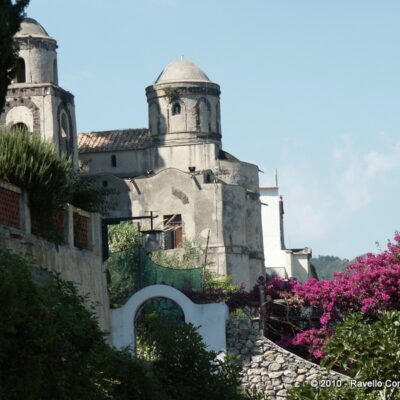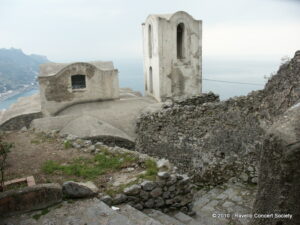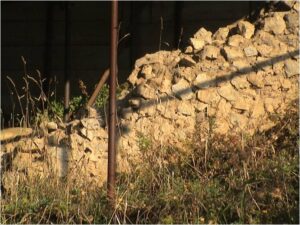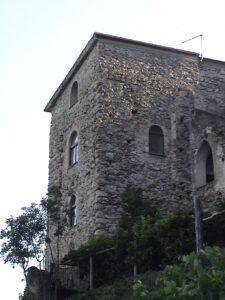MUNICIPALITY: Ravello
NAME: Church and Oratory of the Annunziata
LOCATION: Via Dell’Annunziata
DESCRIPTION: The church and oratory of this complex have access from a portico covered by cross vaults with pointed arches, extrados.
The church has a north-south orientation and has a single entrance on the lintel of which towers the marble crest of the Fusco family. The structure has three naves divided by arches resting on two columns of gray granite (two) and marble (pink and green), with a transept raised by one step and three apses, of which the central one is wider, but all with single-lancet openings; the roof of the aisles is cross-vaulted, while on the transept rises the dome on a drum with a diameter of four meters. The exterior façade to the south shows black tuff decoration defining stringcourses and decorative arches in the single-lancet windows and dome.
The oratory, on the other hand, perpendicular to the church, with a single entrance, surmounted by a large trefoil window, is a vast room, single-nave, with two small apses on the south side (the long side) and a wide apse at the bottom on the west, where a masonry altar surmounted by a Renaissance altarpiece is located, divided into three levels: in the lower one, stucco busts of the Apostles and Christ, now no longer extant, reproduced the Last Supper; in the middle one, the nativity scene; in the upper one, a landscape painting serves as a spacious setting for the scene of the Annunciation; the upper lunette contained the bust of the Virgin with the Angels in stucco (all gone). Along the high perimeter of the walls, emphasizing the impost of an eighteenth-century coffered ceiling, now eliminated, was a grotesque frieze with the coat of arms of the municipality in the beginning.
The oratory certainly predates 1437, because it was on this date the seat of the confraternity of the Battenti and underwent restoration in 1721.
The church, on the other hand, dates from 1277, because it is mentioned in the will of Nicola Rufolo and was granted in patronage to the Fusco family in 1393, then confirmed to the same family when it was loyal to Ladislaus of Durazzo in 1403.
SEE, VISIT, FIND: The church is open only during conferences and concerts.
FRUITION DATA: None
OPPORTUNITIES: The recurring problem of lack FULCHIGNONI G., Ravello. Le cento chiese, Amalfi 2001 IMPERATO G., Ravello nella storia civile e religiosa, Cava d. T. 1990. MANSI L., Ravello sacra-monumentale, Ravello 1887of historical-artistic information on site makes it difficult to enjoy and appreciate a very important asset. At the very least, information panels would be needed.
BIBLIOGRAFIA: FULCHIGNONI G., Ravello. Le cento chiese, Amalfi 2001
IMPERATO G., Ravello nella storia civile e religiosa, Cava d. T. 1990.
MANSI L., Ravello sacra-monumentale, Ravello 1887
Oratorio SS. Annunziata
Il “Simbolo di Ravello”
Characterized by the small bell tower, the high dome of the basilica and the vaults that externally show the cross-ribbed structure, typical of Amalfi Coast architecture, the SS. Annunziata complex has entered the collective imagination as the most characteristic Ravello vision, enriched by the presence of a maritime pine tree, the panorama of the sea and, in the background, the silhouette of Mount Falerio, which towers over Maiori.
It consists of the small basilica and oratory.
The three-aisled basilica, with its simple arches and the presence of cross vaults in the side aisles and the wooden roof in the central one, combines elements of early Christian architecture with those of Romanesque architecture (as can also be seen, always in Ravello, in the Churchs of San Giovanni del Toro, Santa Maria a Gradillo, San Matteo del Pendolo, known as Madonna delle Grazie, and in the lower part of the Cathedral of S. Maria Assunta).
If one were to ask a tourist (or even a local resident) what image most represents Ravello, we would have with mathematical certainty the same answer: the domes of the Annunziata. For very many years, in fact, the structure has been the protagonist of commercials, photos, paintings and posters concerning Ravello
Such importance is due to the beauty of the place where the church is located. It is located, in fact, on the ridge of the mountain overlooking Minori, Maiori and the Gulf of Salerno. The structure, in addition to being in a “scenically strategic” location, can also boast an equally interesting history. The building, in fact, is linked to the most important Ravello families of the Middle Ages: the Rufolo, Fusco, and Acconciaioco families.
The earliest evidence of the church can be inferred from the will of the very rich Nicola Rufolo, dated 1277. The document states that the building passed to the appurtenance of another prominent local family, the Fusco family, which substantially financed its construction.
In 1281 there is the official opening to worship of the church, which, because of its “elegant simplicity” and its importance, has been enriched over time by valuable furnishings and fittings, the fruit of donations from the eminent families of Ravello. Of all these furnishings, unfortunately, no trace remains to us, due to the dismemberment of the patrimony that occurred over the centuries among the Fusco heirs.
In addition to valuable objects, the church was endowed, as early as the 14th century, through the initiative of the Acconciaioco family in particular, with a road that connected the complex both to the center of the town and to other neighboring churches.
From a structural point of view, the building falls fully within the local Romanesque style, due to the sobriety of the structure, the columns of various reused marbles, the presence of a small portico, in front of the main hall, and the constant external ornamental motifs, found in other sacred buildings of the place.
Between the 1500s and 1700s the Annunziata, thanks to the presence of oratory, became the seat of the confraternity of the “Battenti,” which provided for its preservation and maintenance, until the great restoration of 1721.
The church today is no longer active for worship and, as it is deconsecrated, is periodically used as a conference hall or as a venue for other cultural activities.





